The Craig Microscope
invented by
Henry W. Craig, ca.1817 - 1863
by Brian Stevenson
last updated August, 2018
Henry Craig invented a microscope that was both simple to produce and simple to operate (Figure 1). Patented in 1862, the Craig Microscope was heavily marketed throughout the United States. At a retail price of $2 or more, it must have netted its producers a good profit.
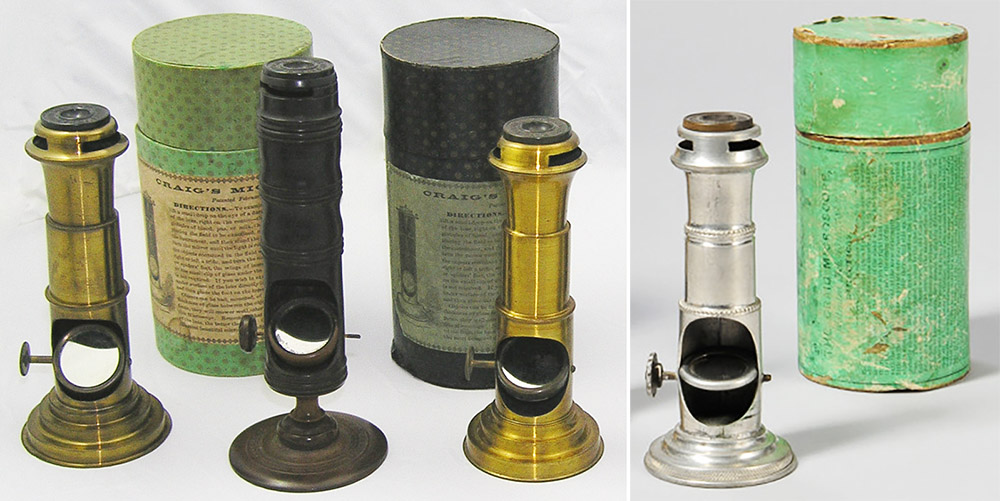
Figure 1.
Examples of Craig Microscopes. The earliest forms were made of a hard brass alloy, some of which were nickel-plated. A gutta percha version was introduced ca. 1863 - there are at least three forms of base for the gutta percha microscope (see Figure 7).
John Phin described the Craig Microscope, “The lens is a fused bead of glass set in a little frame, to the under side of which is attached a thin plate of glass, whose lower surface is exactly in the focus of the bead, so that when a drop of water or vinegar is placed on the glass plate, or such objects as insects' scales, wings, etc., are laid on it, they are exactly in focus. Hence, this microscope is said to require no adjustment for focus. This is true when the objects to be examined are actually in contact with the glass plate, but when we wish to examine objects that are covered with thin glass (as all valuable preparations should be) or objects having a perceptible thickness, it is impossible to adjust it for focus, and hence it is impossible to examine such objects satisfactorily. Besides this, nine-tenths of the microscopes of this pattern in market are very badly made, and distort objects to such an extent that one who has been accustomed to employ a good microscope cannot recognize them”.
While Phin gave an honest description of the Craig Microscope, the device’s advertisements often gave exaggerated reviews of its power and usefulness:
“For any ordinary examination they answer all the purposes of a more expensive microscope; and for the student, is just the thing for every-day use. It is readily adjusted, and magnifies sufficient for all ordinary purposes. It renders the blood, pus, and milk globules, and cancer cells, as well as the animalculae of stagnant water, distinctly visible; shows the tubular structure of the hair, the circulation of the blood in the web of a frog's foot, and opens up the minutiae of creation to the view of the astonished beholder, ‘where the unassisted sight no beauty sees’. It furnishes an endless source of home amusement and instruction to every one, especially to the young”.
“It magnifies about 100 diameters or 10,000 times, and, owing to its simplicity, it is invaluable for physicians, scientific men, students and schools, and for every one who is a lover of the beautiful things of nature, for it opens up an unseen kingdom to the view of the inquiring mind. It is amusing, instructive and useful”.
"Before I was the proprietor of this Craig glass, for which I paid $2.50, I had for ten years used a French instrument, which cost me, I think, $55.00, of feebler power, and less reliable. With the French 'Cressaix’, I searched long and fruitlessly for the 'trichina spiralis' that savants guessed was in our American pork. With the $2.50 Craig I laid hold of it plainly and positively at the second trial”.
“My Craig Microscope, that cost me but $2.50, has, in the two years that I have had it in service, been of more than $25 real practical value to me, besides all the pleasure its use has afforded, and the fund of useful information obtained through it. By its aid I have detected stale fish, meat, and vegetables in market, that otherwise might have been imposed upon me tor good material - arrested incipient sourness in bread, decomposition in butter, and made three milkmen ashamed of dishonest practices. In short, my honest opinion is, that all sorts of people, either in town or country, men and women, masters and misses, can make no more profitable investment, than by sending the price of the Craig Microscope to the maker … and get for it a better instrument than my French one, costing $45”.
A contrasting opinion was published in The Technologist, 1874, “It is no uncommon thing to see, even in respectable journals, advertisements of microscopes which profess to be suited to the wants of physicians and students, and this at a price as low as fifty cents or a dollar. The lenses of these so-called microscopes are nothing but bits of fused glass, which magnify indeed, but which show nothing clearly or distinctly. Of this kind is the well-known Craig Microscope, probably one of the most worthless contrivances ever offered to the public”.
Despite their inadequacies, Craig Microscopes are generally scarce and in high demand these days. Complete instruments usually command prices in excess of $200 US. The rarer gutta percha versions may fetch 5-10 times that price. Due to the loose fit of the lens on the body, lenses have often been lost. A lens-less body might be acquired for a small price, while a lens alone might sell for nearly as much as a complete Craig Microscope.
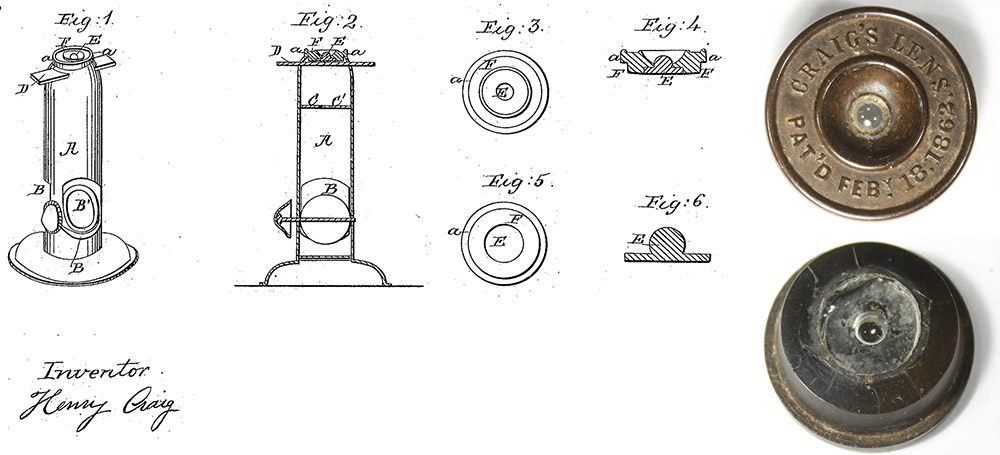
Figure 2.
(Left) Excerpts from Henry Craig’s 1862 patent. Cross section views of the lens are shown in his Figs. 4 and 6, showing that the flint glass sphere is to be fused with the lower crown glass disc. (Right)Views of a surviving Craig lens.
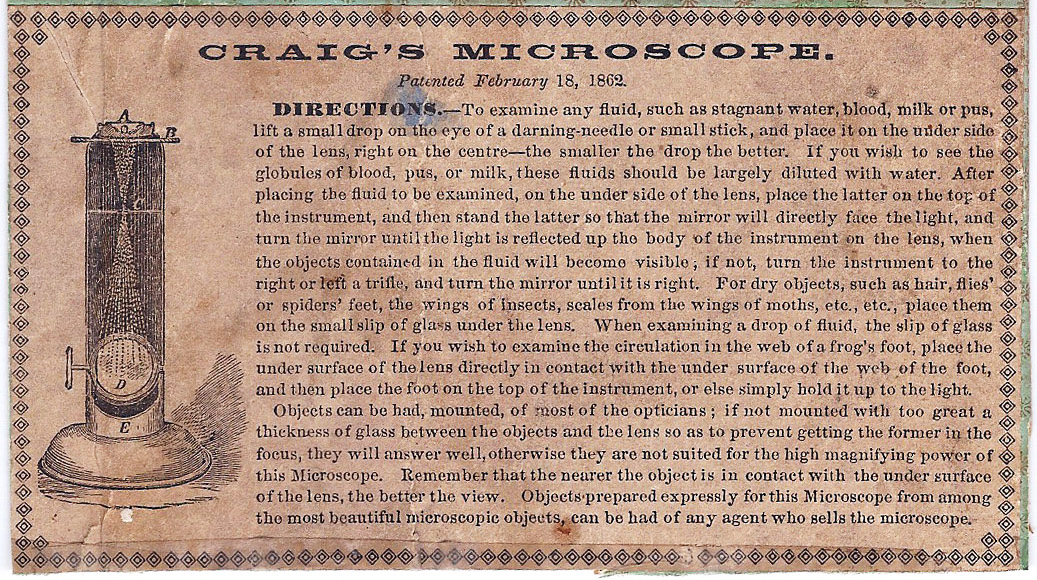
Figure 3.
Henry Craig’s instructions on how to use his microscope, from an original cardboard container.
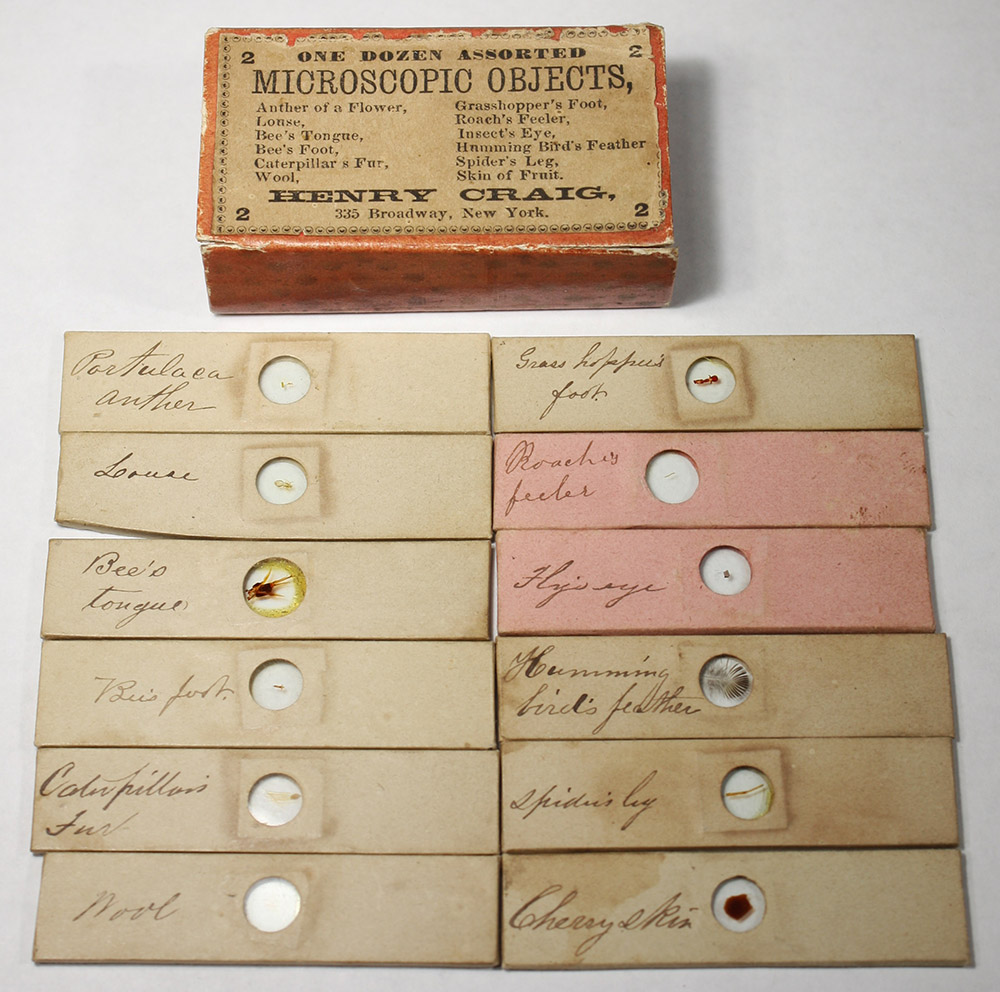
Figure 4.
A set of a dozen microscope slides, sold to accompany the Craig Microscope.
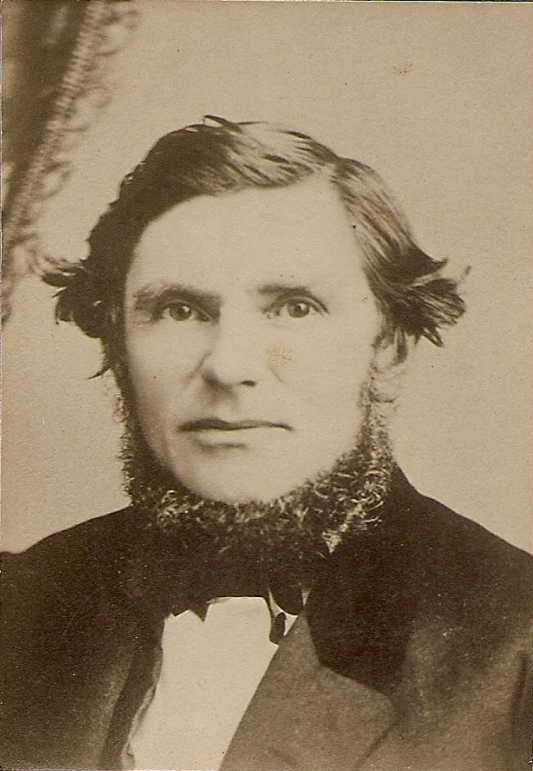
Figure 5.
Henry Craig. Adapted for nonprofit, educational purposes from https://www.ancestry.co.uk/mediaui-viewer/tree/57285569/person/48401540961/media/e43b05f6-2833-4abe-8b57-0d81e4b0b664.
Henry Craig, “of Cleveland, in the county of Cuyahoga and State of Ohio” received a patent for his microscope on February 18, 1862. This was the fourth microscope-related patent issued in the USA. Craig’s patent describes his lens as a sphere of flint glass fused onto a thin disc of crown glass (Figure 2). Other Craig Microscope lenses, presumably later, mass-produced versions, consist of a separate sphere and disc, the two placed such that the lower side of the disc is at the point of focus of the spherical lens (as described by Phin - see above).
As far as is known, Craig was self-taught. The Cleveland City Directory from 1861 listed Craig as being a janitor at the Cleveland Homeopathical Medical College, living with his wife and children in the “College Building”. The patent application was witnessed by two respected men who were associated with the College, W.H. Burridge (a Trustee) and Jehu Brainerd (a Professor who was also an inspector in the US Patent Office).
Craig was originally from England. His family name was occasionally spelled “Cragg” in official records. He married Lydia Wraight, in Canterbury, Kent on October 15, 1839. They had two daughters, Elizabeth (born 1840) and Jane (born 1842).
The family left for the USA in 1850, arriving in New York on May 18. They soon moved to Brooklyn, Ohio (adjacent to Cleveland), arriving in time to be recorded in that year’s federal census. It listed Henry’s occupation as “hair dresser”. Three further children were born, Henry W. (born 1854), Charlotte (born 1857), and Ella (born 1861).
After the Craig Microscope was patented, a distribution deal was arranged with C.H. Wheeler & Co., of Boston, Massachusetts (Figures 6 - 8). Wheeler described themselves as “commission dealers in patents and patent goods”, and so would have been a good outlet for novice entrepreneurs who needed a nationwide distributor, such as Craig.
Presumably, Henry Craig manufactured the early instruments himself. The lens was made from a droplet of melted glass that did not require grinding, the only real skill being the fusion of the droplet with the crown glass disc. The microscope bodies were made from cast brass or gutta percha, and a few other simple components that would not require precise skills in metal smithing. Some of the gutta-percha bases are marked as having been manufactured by the Novelty Rubber Co., New Brunswick, New Jersey, and knobs for adjusting mirror angle are often marked “Goodyear’s Pat. N.R. Co.”. It is possible that production of many Craig Microscope bodies was similarly outsourced.
New distribution schemes were developed in 1863. To judge from duration of identified advertisements, for a brief time, one could purchase a Craig Microscope directly from the maker (Figure 9). Distribution arrangements were made during 1863-64 with one or two firms in New York City, located at 335 Broadway and 180 Centre Street (Figure 10). It is not clear whether these were two sites of the same business, or two different businesses. 335 Broadway was known as the Moffat Building, an architectural gem that was then home to a book publisher, several lawyers, and other businesses. One John Ellis occupied 180 Centre Street in 1866, at that time described as ”Manufacturer and Wholesale Dealer of the Craig Microscope”. It is possible that Ellis was Craig’s 180 Centre distributor in 1863. Quite a few magazines advertised that one could acquire Craig Microscopes through them - it is not known whether those editors had direct connections to Craig, or if they operated through his New York distributors (Figures 11 and 12)
Henry Craig died on April 26, 1864. His wife, Lydia, had 5 children to care for, with her only son then being not quite 10 years old. Licensing microscope distribution, and probably construction, would have brought the Craig family a good income for very little effort.
As noted above, John Ellis, of New York, advertised in 1866 to be a manufacturer of Craig Microscopes (figure 13).
In 1868, George Mead, of Racine, Wisconsin began advertising that he was “the sole proprietor and manufacturer of the Craig Microscope”. Advertisements from New York ceased around that time, so Mead’s statement is probably true. By 1869, Mead was selling through a Post Office box in Chicago (Figure 14).
Another distributor appeared in late 1870, Theodore Tusch, of New York (Figure 15). His advertisements continued into 1871.
Judging from relative abundance of advertisements, production of the Craig Microscope probably ceased during the early 1870s. These later instruments were likely the type with two-part lenses, as described by Phin. Of those, The Richmond and Louisville Medical Journal wrote in 1872, “A few years since an efficient and economical microscope, known as the Craig microscope, was well made and largely sold in the United States. It has passed into other hands, and is now comparatively worthless”.
Around 1872, a very similar microscope came to market, the “Globe” microscope (Figures 16 and 17). It appears to be fundamentally the same as the Craig, except for the lens setup: there is a single glass bead lens, and the height of the lens mount can be adjusted a short distance, permitting a limited range of focus adjustment. George Mead, who previously sold (and likely manufactured) Craig Microscopes, was stated to be the Globe’s maker: “The Globe Microscope is the best instrument for the price ever invented. Its magnifying power is truly astonishing, being 100 diameters. Its construction is somewhat similar to that of the Craig Microscope; but the lens, instead of being immoveable, is easily and accurately adjusted to suit the eye and the object. To the physician of limited means and practice, the Globe Microscope answers many of the purposes of the high cost instruments. The manufacturer, Mr. Geo. Mead, of Racine, Wis., also furnishes a large collection of mounted objects, at very reasonable prices.” Advertisements indicate that the Globe microscope was sold through at least 1878. Very few of these microscopes are known to exist today.
“Henry Craig” was listed as a microscope manufacturer in directories of Cleveland through 1873. The address was given as the family home, 19 Ohio Street. The microscopes were likely made elsewhere, while the “Henry Craig” business collected profits from licensing. City directories from 1874 onward lacked references to Craig microscopes, suggesting that the family had sold the patent, or had ceased to do business. Son Henry is listed in the 1874 directory, as an artist at 19 Ohio Street. Through the following years, he also worked as an art teacher in Cleveland public schools and as a draughtsman. He moved to Marietta, Ohio in 1884, attended art school at the South Kensington Museum in London, and operated Craig’s Photographic Art Parlor through the turn of the century. The microscope inventor’s widow, Lydia, remained in the Ohio Street house with her unmarried daughters, and died in 1895.
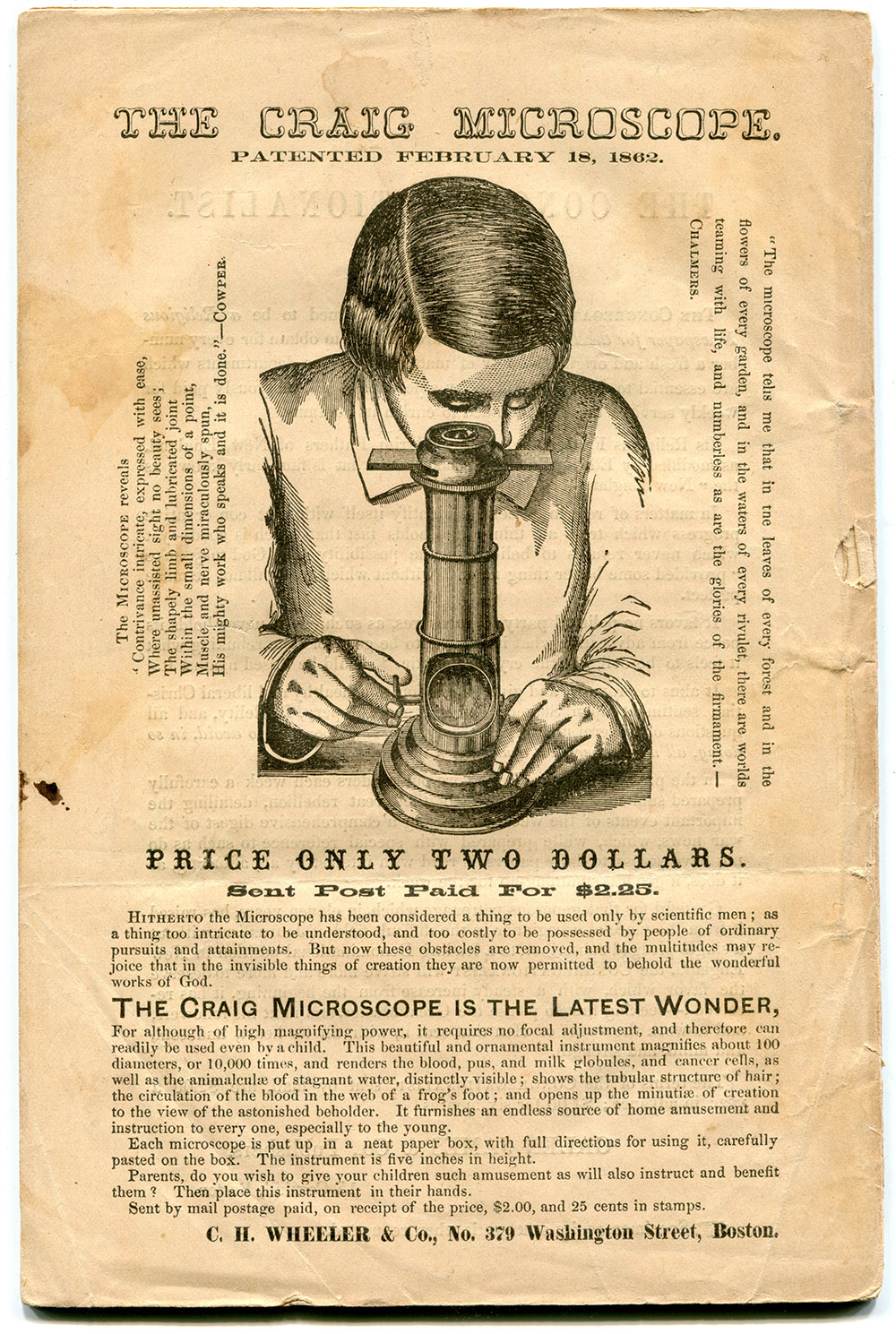
Figure 6.
An August, 1862 advertisement for the Craig Microscope, sold by C.H. Wheeler & Co., Boston. The size of the microscope is grossly exaggerated in the engraving. They are actually 5 inches / 12 cm tall.
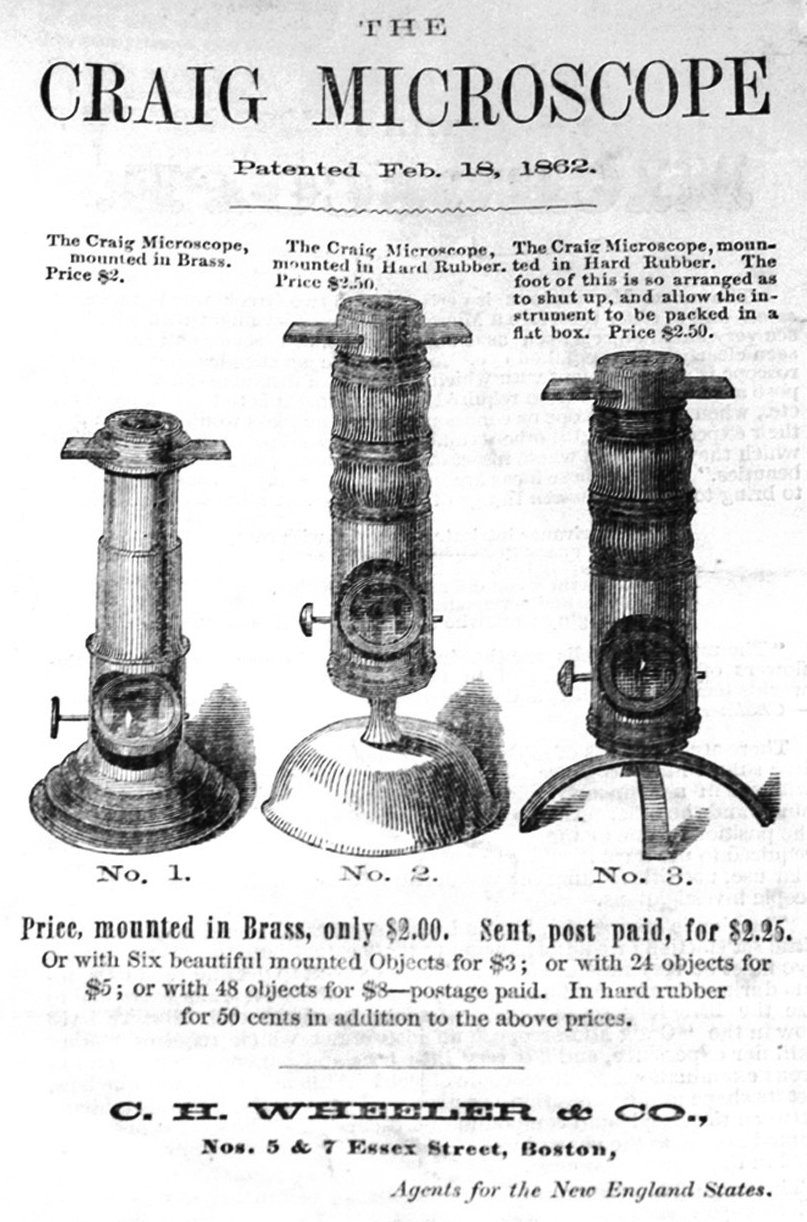
Figure 7.
A ca. 1864 advertisement, illustrating the brass model and the gutta percha model with erect and folding bases.
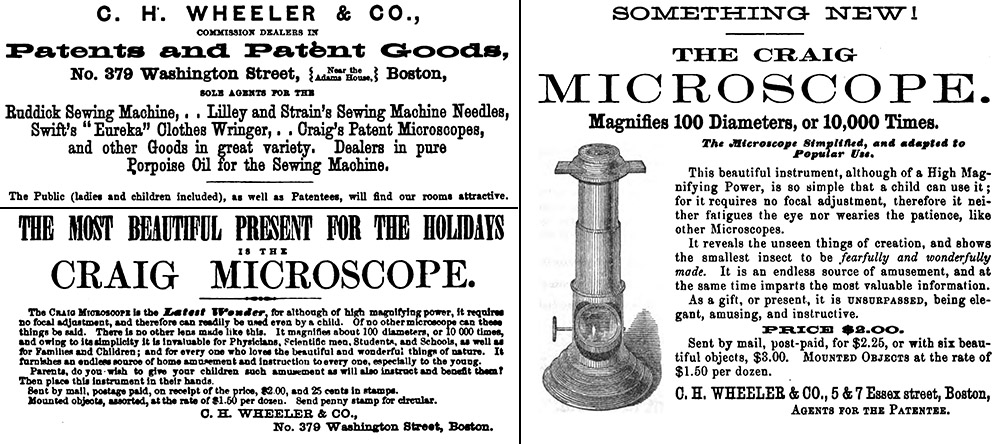
Figure 8.
Additional advertisements from C.H. Wheeler for the Craig Microscope, late 1862 through early 1863.
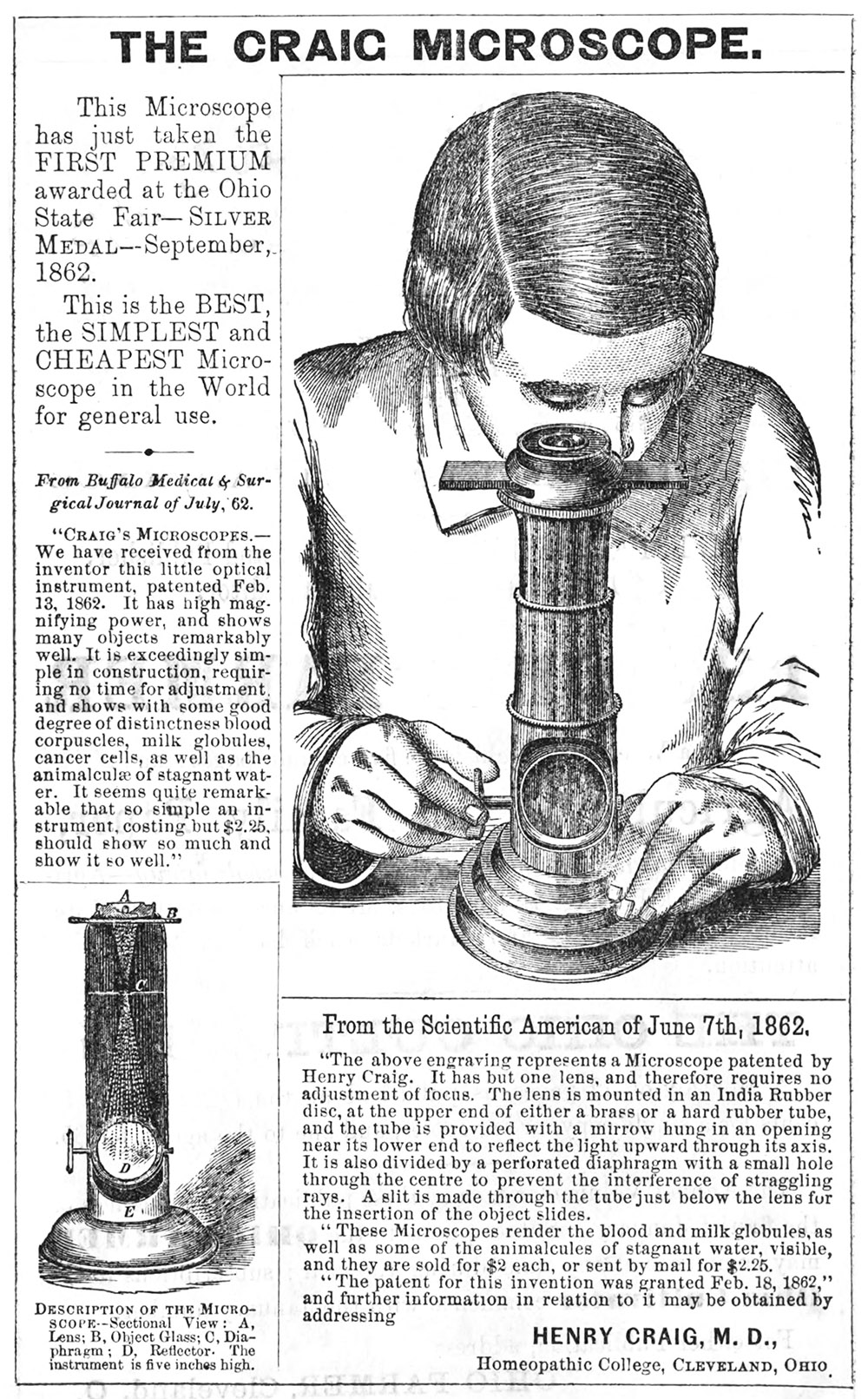
Figure 9.
An 1863 advertisement. One could then order a Craig Microscope directly from the inventor. Note that Henry Craig had awarded himself an M.D. degree.

Figure 10.
1863-64 advertisements. The Craig Microscope was simultaneously available from two sources in New York, located at 180 Centre Street and 355 Broadway. The three advertisements shown in the middle appeared on the same page of the May 7, 1864, issue of “Scientific American”.
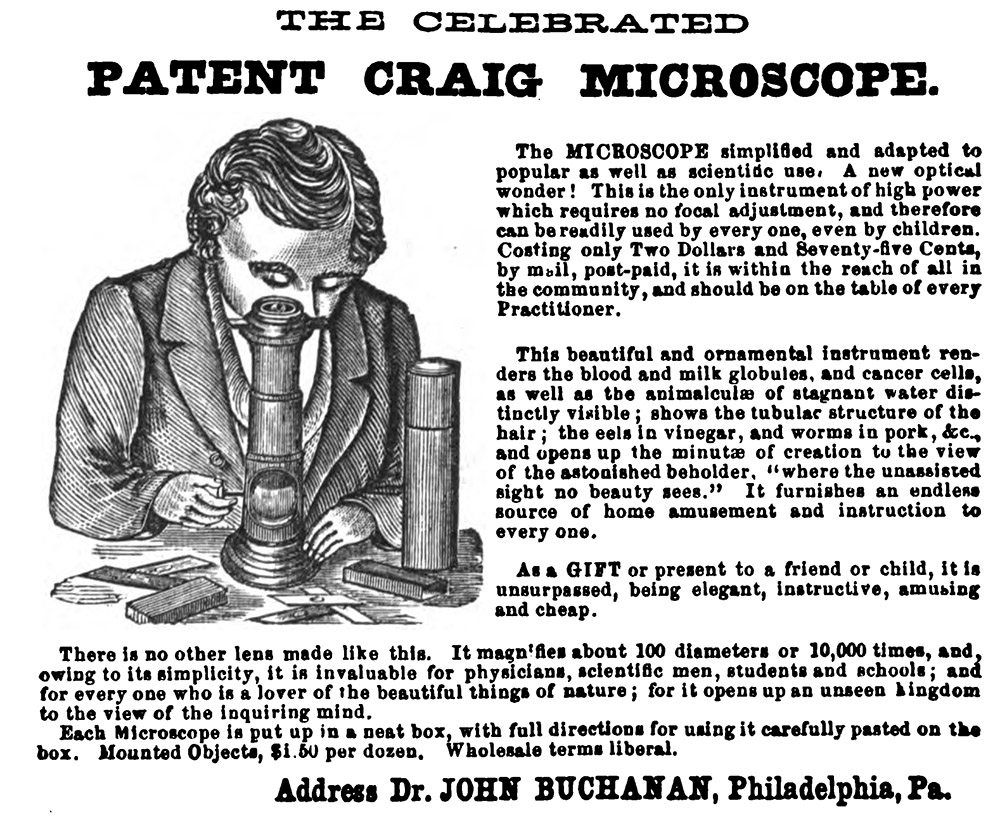
Figure 11.
Several magazines offered direct sales of the Craig Microscope, such as this 1863 advertisement from “The Eclectic Medical Journal of Pennsylvania” (Dr. John Buchanan was the Editor).
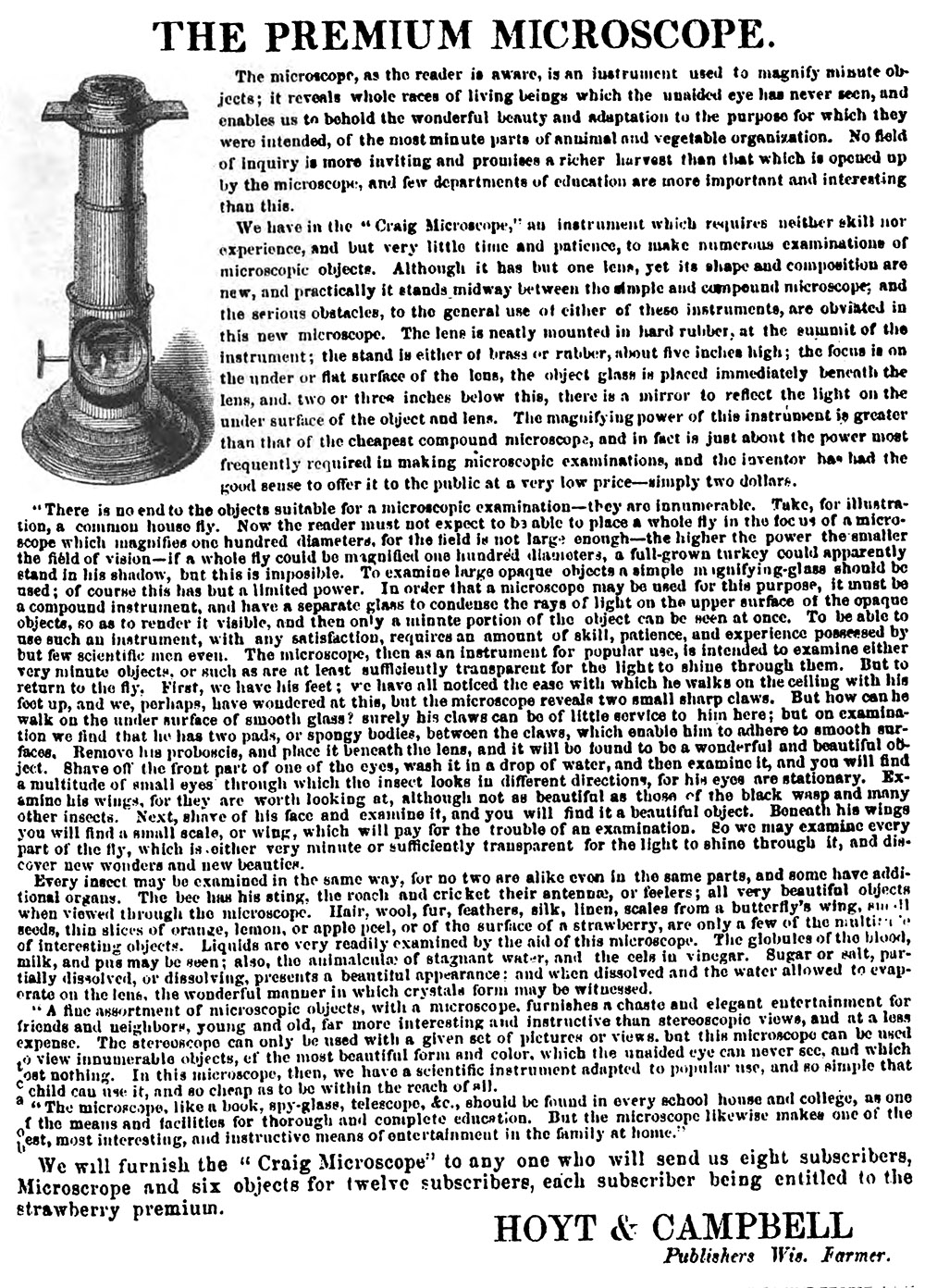
Figure 12.
The Craig Microscope was offered as a “premium” by a number of magazines. This announcement, from an 1863 issue of “The Wisconsin Farmer” boasted the qualities of the Craig Microscope, and offered it as a free gift to anyone who brought in eight new magazine subscribers.

Figure 13.
Description of goods available from John Ellis, 180 Centre Street, New York. It is not known whether he actually manufactured Craig Microscopes. Of note, the “Bellevue” stereoscope had previously been retailed by C.H. Wheeler, suggesting that Ellis acquired a number of Wheeler’s distribution clients. From “The Merchants' Directory”, 1866.
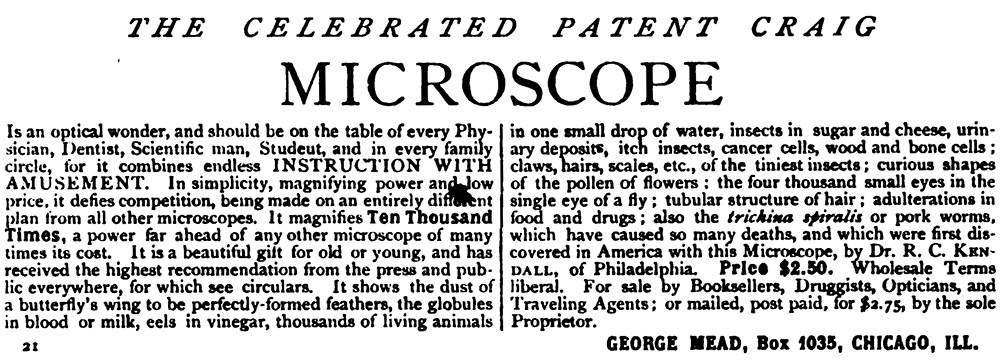
Figure 14.
George Mead began advertising ca. 1869 that he was the sole proprietor of the Craig Microscope. He was based in Racine, Wisconsin, but sometimes sold from Chicago, Illinois. This advertisement is from the January 8, 1870, issue of the Yale “College Courant”.
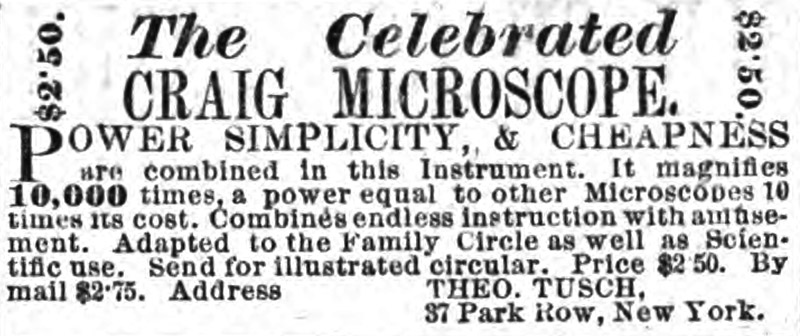
Figure 15.
October, 1870 advertisement from a different distributor, Theo. Tusch, of New York City.
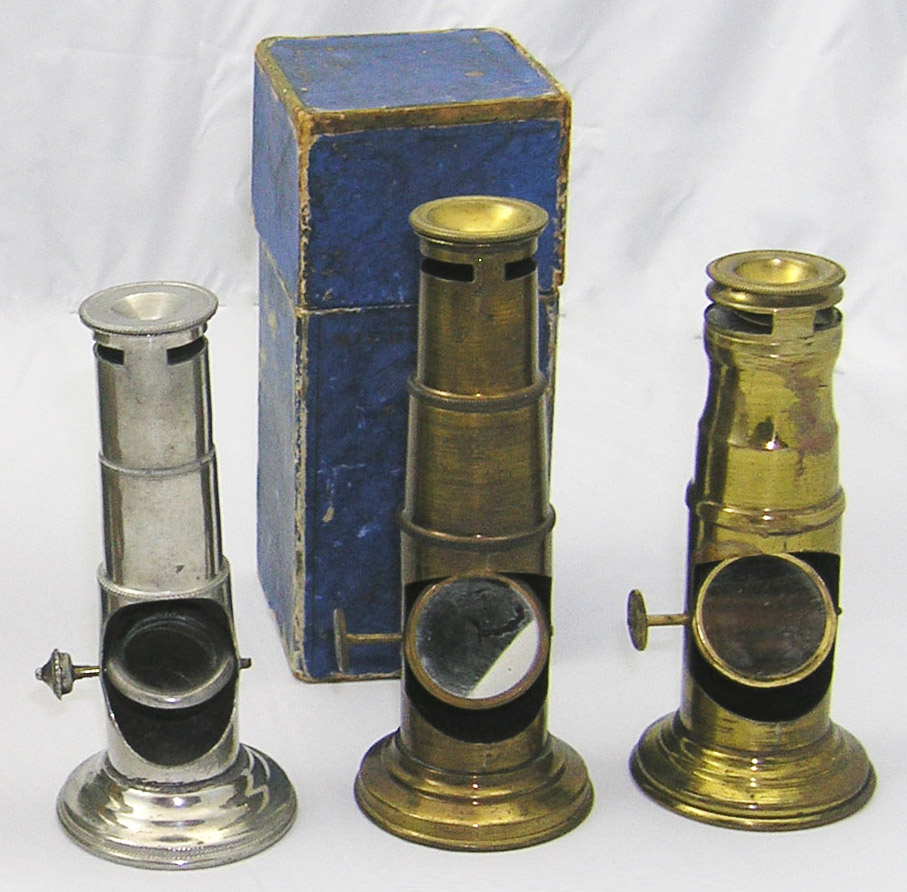
Figure 16.
Three “Globe” microscopes, circa 1872-78. They are very similar to the Craig, although the simple lens has a small amount of vertical movement, permitting limited degrees of focus. Globe microscopes are very scarce nowadays.

Figure 17.
1872 advertisements for the Globe Microscope. It was evidently manufactured by George Mead, who had previously retailed the Craig Microscope. Other advertisements indicate that they were produced until at least 1878.
Acknowledgement
Many thanks to Joe Zeligs for generously providing valuable information and pictures.
Resources
The American Agriculturalist (1866) Advertisement for the Craig Microscope, Vol. 25, page 272
The American Bibliopolist (1869) Advertisement for the Craig Microscope, Vol. 1, page 407
The American Educational Monthly (1872) Advertisement for the Globe microscope, Vol. 9
The American Medical Times (1868) Advertisements for the Craig Microscope, Vol. 7, numerous issues
The Atlantic (1862) Advertisement for the Craig Microscope, Vol. 10, back pages
Bell, John B. (1994) The Craig Microscope, Rittenhouse, Vol. 8, May issue
The Boston Directory (1862) Listing for C.H. Wheeler, page 89
Boston Journal of Chemistry (1878) Advertisement for the Globe microscope, Vol. 12, Supplement of 1877-78, first page
Buffalo Medical Journal (1872) The Globe microscope, Vol. 27, page 443
Burial record of Henry Craig (1864) accessed through familysearch.org
Cleveland City Directory (1861) “Craig Henry, janitor Homoepathic College, h College Building, Ohio”, page 39
Cleveland City Directory (1867) “Craig Henry, manufac’r Craig microscope, 19 Ohio, h same”, page 129
Cleveland City Directory (1867) “Microscope Manufacturer: Craig Henry, 19 Ohio”, page 304
Cleveland City Directory (1868) “Craig Henry, man’facturer Craig microscope, h 19 Ohio”, page 137
Cleveland City Directory (1873) “Craig Henry W., microscope mnfr. r.14 Walworth pl.”, page 128
Cleveland City Directory (1874) “Craig Henry, artist, r. 19 Ohio”, page 150
Cleveland City Directory (1876) “Craig Henry, asst. teacher drawing, pub. schools, r. 19 Ohio”, page 148
Cleveland City Directory (1878) “Craig Henry, artist, r. 19 Ohio”, page 133
The Cleveland Homeopathic Reporter (1901), Vol. 2, page 10
The College Courant (1870) Advertisement for the Craig Microscope, Vol. 6, January 8 front page
The Cultivator (1864) Advertisement for the Craig Microscope, Vol. 12, page 103
The Eclectic Medical Journal (1872) Advertisement for the Globe Microscope, Vol. 32, numerous issues
England and US census and other records, accessed through ancestry.com and familysearch.org
The Illinois Teacher (1863) Advertisement for the Craig Microscope, Vol. 9
Isaacs, Isaac A. (1863) The Terrifically Thrilling Poem of "The Fair Inez”, Isaacs, Cleveland, Ohio, Advertisement for Craig Microscope at the back of the pamphlet
Journal of Materia Medica (1868) The Craig Microscope, Vol. 7, pages 254-255
“Madeline” (1866) Marvels of the microscope (testimonial advertisement for the Craig Microscope), The Kaleidoscope, page 129
The Massachusetts Teacher (1864) The microscope and the stereoscope, Vol. 17, pages 73-74
The Merchants’ Directory (1866) Listing for John Ellis, page 114, J. Harford, New York
Patent 34,409, to Henry Craig, Cleveland, Ohio (1862) accessed through http://www.antique-microscopes.com/patents/patent_images.html
Phin, John (1882) How to Use the Microscope, Industrial Publication Co., New York, pages 38-39
The Richmond and Louisville Medical Journal (1872) “A few years since an efficient and economical microscope, known as the Craig microscope, was well made and largely sold in the United States. It has passed into other hands, and is now comparatively worthless. No one can rely upon the honesty of a manufacturer who advertises this instrument as having a magnifying power of 10,000 diameters, when its former maker never succeeded in obtaining a power over 100 diameters. The advertisements of this microscope manifest not only dishonesty, but the grossest ignorance on the part of the manufacturers”, Vol. 13, pages 509-510
Robinson, Savage, & Co.’s Cleveland Directory (1878) “Craig, H.W., draughtsman Hubbard & Eddy, r. 19 Ohio”, page 143
The Saint Louis Medical Reporter (1868) The Craig Microscope, Vol. 3, pages 419-420
Scientific American (1864) Advertisements for the Craig Microscope, Vol. 10, page 303
Scientific American (1870) Advertisement for the Craig Microscope, Vol. 23, page 270
Scientific American (1871) Advertisements for the Craig Microscope, Vol. 24, pages 154 and 235
Student and Schoolmate (1862) Advertisement for the Craig Microscope, Vol. 11
The Technologist (1874) A really good microscope, Vol. 5, page 63
The United States Medical Investigator (1874) The Globe Microscope, Vol. 10, page 320
Weidman, Jeffrey (2000) Artists in Ohio, 1787-1900, Kent State University Press, Kent, Ohio, page 192
Weisman, Winston (1954) Commercial palaces of New York, The Art Bulletin, Vol. 36, pages 285-302
The Wisconsin Farmer (1863) The Craig Microscope, Vol. 15, pages 228-230
The Wisconsin Farmer (1863) The premium microscope, and advertisements for the Craig Microscope, Vol. 15, numerous issues
















